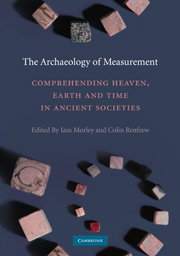Book contents
- Frontmatter
- Contents
- List of figures and tables
- List of contributors
- Acknowledgements
- The Archaeology of Measurement
- Introduction: Measure: Towards the construction of our world
- SECTION I NUMBER: COUNTING, MATHEMATICS AND MEASURE
- SECTION II MATERIALISING THE ECONOMY
- SECTION III DIMENSIONS AND BELIEF
- SECTION IV CALENDAR AND COSMOLOGY
- 14 The measurement of time and distance in the heavens above Mesopotamia, with brief reference made to other ancient astral sciences
- 15 Evolution of the calendar in Shang China
- 16 The measure of time in Mesoamerica: From Teotihuacan to the Maya
- 17 Measuring time, sacred space, and social place in the Inca Empire
- 18 Measuring time in the European Neolithic? The function and meaning of Central European circular enclosures
- SECTION V THE SPIRITUALITY OF MEASURE
- Index
- References
17 - Measuring time, sacred space, and social place in the Inca Empire
Published online by Cambridge University Press: 05 June 2012
- Frontmatter
- Contents
- List of figures and tables
- List of contributors
- Acknowledgements
- The Archaeology of Measurement
- Introduction: Measure: Towards the construction of our world
- SECTION I NUMBER: COUNTING, MATHEMATICS AND MEASURE
- SECTION II MATERIALISING THE ECONOMY
- SECTION III DIMENSIONS AND BELIEF
- SECTION IV CALENDAR AND COSMOLOGY
- 14 The measurement of time and distance in the heavens above Mesopotamia, with brief reference made to other ancient astral sciences
- 15 Evolution of the calendar in Shang China
- 16 The measure of time in Mesoamerica: From Teotihuacan to the Maya
- 17 Measuring time, sacred space, and social place in the Inca Empire
- 18 Measuring time in the European Neolithic? The function and meaning of Central European circular enclosures
- SECTION V THE SPIRITUALITY OF MEASURE
- Index
- References
Summary
The Inca Empire of Andean South America emerged in the 15th century AD as one of the great political triumphs of world history. In a short 100 or so years, the Inca developed in the central Andean highlands out of a multitude of competing polities in the post–Middle Horizon period (Figure 17.1). The Middle Horizon, circa AD 500–1100, represented the apogee of the three first-generation states of the Andes – first Moche in the first centuries AD up to around AD 700, then Wari and Tiwanaku (Figure 17.2). The latter two states developed almost in tandem circa AD 500–1000 extending their reach over most of the Andean highlands, from northern Peru to north central Chile.
The collapse of the Wari and Tiwanaku states created a volatile political context throughout the region. In the north coast, several polities developed out of the remains of the Moche state, ultimately culminating in the first empire of Chimor in the beginning of the second millennium AD. Moche defined statecraft as it was practiced in the pre–European contact Andes, beginning at the end of the first millennium BCE and continuing into the middle of the first millennium AD. Moche culture most likely directly influenced Wari and Chimu and indirectly influenced Tiwanaku as these two cultures developed their models of statecraft in the immediate post-Moche periods.
The Quechua-speaking Inca peoples were one of a number of smaller polities that developed in this general cultural context of the post–Middle Horizon period.
- Type
- Chapter
- Information
- The Archaeology of MeasurementComprehending Heaven, Earth and Time in Ancient Societies, pp. 216 - 228Publisher: Cambridge University PressPrint publication year: 2010
References
- 1
- Cited by



